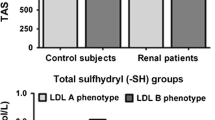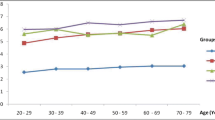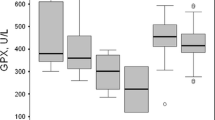Abstract
Introduction
This study aimed to evaluate the role of protein oxidation and DNA damage in the elderly hypertensive (HT) patients.
Materials and methods
This study consisted of four groups: two elderly groups with 30 HT patients and 30 normotensive healthy volunteers, and two young groups with 30 HT patients and 30 normotensive healthy volunteers. Plasma total thiol (T-SH), advanced oxidation protein products (AOPPs), protein carbonyl (PCO), ischemia modified albumin (IMA), urine 8-hydroxy-2′-deoxyguanosine (8-OHdG), and prooxidant–antioxidant balance (PAB) levels were measured.
Results
In the elderly HT group AOPPs, PCO, 8-OHdG, and PAB were significantly higher than the elderly control group. In the young HT group T-SH levels were significantly lower and the other oxidative stress parameters were significantly higher than the young control group. In the elderly control group AOPPs, PCO, IMA, 8-OHdG and PAB were significantly higher than the young control group. T-SH was significantly lower in the elderly control than the young control group. In the elderly HT group, T-SH levels were significantly lower and AOPPs, PCO, IMA, 8-OHdG, and PAB levels were significantly higher than the young HT group.
Conclusion
Protein and DNA cell damage occurs by oxidation of free radicals throughout life. Our study supports the view that these radicals may be responsible for the development of hypertension with aging process. Urine 8-OHdG levels can be used as a marker for oxidative DNA damage in the elderly hypertensive patients. Finally, our results suggest that oxidative stress may influence both the development and progression of hypertension and aging.


Similar content being viewed by others
References
Logan AG (2011) Hypertension in aging patients. Expert Rev Cardiovasc Ther 9:113–120
Cakatay U, Kayali R, Uzun H (2008) Relation of plasma protein oxidation parameters and paraoxonase activity in the ageing population. Clin Exp Med 8:51–57
Beckman KB, Ames BN (1998) The free radical theory of aging matures. Physiol Rev 78:547–581
Rubio-Ruiz ME, Pérez-Torres I, Soto ME et al (2014) Aging in blood vessels. Medicinal agents FOR systemic arterial hypertension in the elderly. Ageing Res Rev 18:132–147
Reaven PD, Napoli C, Merat S et al (2000) Lipoprotein modification and atherosclerosis in aging. Exp Gerontol 34:527–537
Seres I, Paragh G, Deschene E et al (2004) Study of factors influencing the decreased HDL associated PON1 activity with aging. Exp Gerontol 39:59–66
Dincer Y, Sekercioglu N, Pekpak M et al (2008) Assessment of DNA oxidation and antioxidant activity in hypertensive patients with chronic kidney disease. Ren Fail 30(10):1006–1011
Hu ML (1994) Measurement of protein thiol groups and glutathione in plasma. Methods Enzymol 233:381–385
Gelisgen R, Genc H, Kayali R et al (2011) Protein oxidation markers in women with and without gestational diabetes mellitus: a possible relation with paraoxonase activity. Diabetes Res Clin Pract 94:404–409
Alamdari DH, Ghayour-Mobarhan M, Tavallaie S et al (2008) Prooxidant-antioxidant balance as a new risk factor in patients with angiographically defined coronary artery disease. Clin Biochem 41:375–380
American Diabetes Association (2003) Diabetic nephropathy. Diabetes Care 26(Suppl 1):S94–S98
Nakamoto H, Kaneko T, Tahara S et al (2007) Regular exercise reduces 8-oxodG in the nuclear and mitochondrial DNA and modulates the DNA repair activity in the liver of old rats. Exp Gerontol 42:287–295
Berlett BS, Stadtman ER (1997) Protein oxidation in aging, disease, and oxidative stress. J Biol Chem 272:20313–20316
Stadtman ER (2001) Protein oxidation in aging and age-related diseases. Ann N Y Acad Sci 928:22–38
Çakatay U, Kayali R (2005) Plasma protein oxidation in aging rats after alpha-lipoic acid administration. Biogerontology 6:87–93
Young IS, Woodside JV (2001) Antioxidants in health and disease. J Clin Pathol 54:176–186
Salive ME, Cornoni-Huntley J, Phillips CL et al (1992) Serum albumin in older persons: relationship with age and health status. J Clin Epidemiol 45:213–221
Gom I, Fukushima H, Shiraki M et al (2007) Relationship between serum albumin level and aging in community-dwelling self-supported elderly population. J Nutr Sci Vitaminol 53:37–42
Campion EW, deLabry LO, Glynn RJ (1988) The effect of age on serum albumin in healthy males: report from the Normative Aging Study. J Gerontol 43:M18–M20
Caner M, Karter Y, Uzun H et al (2006) Oxidative stress in human in sustained and white coat hypertension. Int J Clin Pract 60:1565–1571
Agarwal S, Sohal RS (1993) Relationship between aging and susceptibility to protein oxidative damage. Biochem Biophys Res Commun 194:1203–1206
Sohal RS, Agarwal S, Sohal BH (1995) Oxidative stress and aging in the Mongolian gerbil (Meriones unguiculatus). Mech Ageing Dev 81:15–25
Piwowar A, Knapik-Kordecka M, Warwas M (2008) Ischemia-modified albumin level in type 2 diabetes mellitus: preliminary report. Dis Markers 24:311–317
Roy D, Quiles J, Gaze DC et al (2006) Role of reactive oxygen species on the formation of the novel diagnostic marker ischaemia modified albumin. Heart 92:113–114
Toker A, Mehmetoglu I, Yerlikaya FH et al (2013) Investigation of oxidative stress markers in essential hypertension. Clin Lab 59:107–114
Kim JY, Prouty LA, Fang SC et al (2009) Association between fine particulate matter and oxidative DNA damage may be modified in individuals with hypertension. J Occup Environ Med 51:1158–1166
Negishi H, Ikeda K, Kuga S et al (2001) The relation of oxidative DNA damage to hypertension and other cardiovascular risk factors in Tanzania. J Hypertens 19:529–533
Loft S, Vistisen K, Ewertz M et al (1992) Oxidative DNA damage estimated by 8-hydroxydeoxyguanosine excretion in humans: influence of smoking, gender and body mass index. Carcinogenesis 132:2241–2247
Subash P, Gurumurthy P, Sarasabharathi A et al (2010) Urinary 8-OHdG: a marker of oxidative stress to DNA and total antioxidant status in essential hypertension with South Indian population. Indian J Clin Biochem 25:127–132
Izzo JL Jr (2001) Aging and systolic hypertension: cluster patterns and problem-solving strategies to answer the genetic riddle. Hypertension 37:1067–1068
Acknowledgments
This work was supported by The Research Fund of Istanbul University (Project Number 30184).
Author information
Authors and Affiliations
Corresponding author
Ethics declarations
Conflict of interest
None.
Statement of human and animal rights
The study has been approved by the ethics committee of the Cerrahpasa Medical Faculty.
Informed consent
Written informed consent was obtained from each subject.
Rights and permissions
About this article
Cite this article
Yavuzer, S., Yavuzer, H., Cengiz, M. et al. The role of protein oxidation and DNA damage in elderly hypertension. Aging Clin Exp Res 28, 625–632 (2016). https://doi.org/10.1007/s40520-015-0464-7
Received:
Accepted:
Published:
Issue Date:
DOI: https://doi.org/10.1007/s40520-015-0464-7




